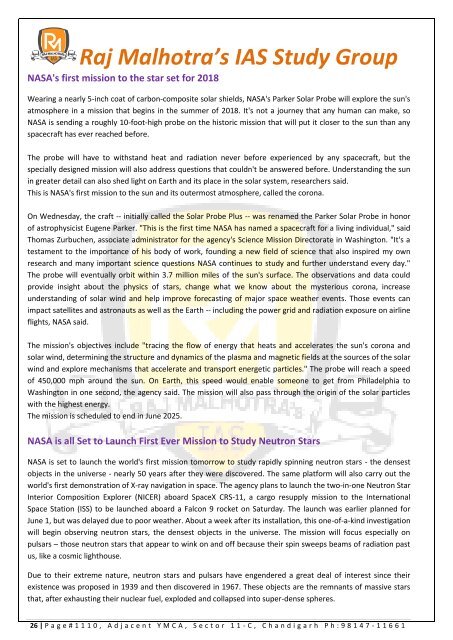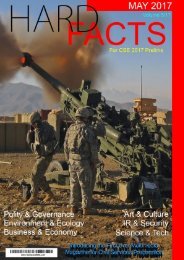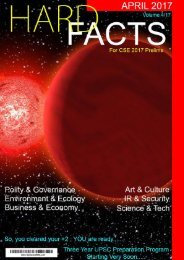Create successful ePaper yourself
Turn your PDF publications into a flip-book with our unique Google optimized e-Paper software.
Raj Malhotra’s IAS Study Group<br />
NASA's first mission to the star set for 2018<br />
Wearing a nearly 5-inch coat of carbon-composite solar shields, NASA's Parker Solar Probe will explore the sun's<br />
atmosphere in a mission that begins in the summer of 2018. It's not a journey that any human can make, so<br />
NASA is sending a roughly 10-foot-high probe on the historic mission that will put it closer to the sun than any<br />
spacecraft has ever reached before.<br />
The probe will have to withstand heat and radiation never before experienced by any spacecraft, but the<br />
specially designed mission will also address questions that couldn't be answered before. Understanding the sun<br />
in greater detail can also shed light on Earth and its place in the solar system, researchers said.<br />
This is NASA's first mission to the sun and its outermost atmosphere, called the corona.<br />
On Wednesday, the craft -- initially called the Solar Probe Plus -- was renamed the Parker Solar Probe in honor<br />
of astrophysicist Eugene Parker. "This is the first time NASA has named a spacecraft for a living individual," said<br />
Thomas Zurbuchen, associate administrator for the agency's Science Mission Directorate in Washington. "It's a<br />
testament to the importance of his body of work, founding a new field of science that also inspired my own<br />
research and many important science questions NASA continues to study and further understand every day."<br />
The probe will eventually orbit within 3.7 million miles of the sun's surface. The observations and data could<br />
provide insight about the physics of stars, change what we know about the mysterious corona, increase<br />
understanding of solar wind and help improve forecasting of major space weather events. Those events can<br />
impact satellites and astronauts as well as the Earth -- including the power grid and radiation exposure on airline<br />
flights, NASA said.<br />
The mission's objectives include "tracing the flow of energy that heats and accelerates the sun's corona and<br />
solar wind, determining the structure and dynamics of the plasma and magnetic fields at the sources of the solar<br />
wind and explore mechanisms that accelerate and transport energetic particles." The probe will reach a speed<br />
of 450,000 mph around the sun. On Earth, this speed would enable someone to get from Philadelphia to<br />
Washington in one second, the agency said. The mission will also pass through the origin of the solar particles<br />
with the highest energy.<br />
The mission is scheduled to end in <strong>June</strong> 2025.<br />
NASA is all Set to Launch First Ever Mission to Study Neutron Stars<br />
NASA is set to launch the world's first mission tomorrow to study rapidly spinning neutron stars - the densest<br />
objects in the universe - nearly 50 years after they were discovered. The same platform will also carry out the<br />
world's first demonstration of X-ray navigation in space. The agency plans to launch the two-in-one Neutron Star<br />
Interior Composition Explorer (NICER) aboard SpaceX CRS-11, a cargo resupply mission to the International<br />
Space Station (ISS) to be launched aboard a Falcon 9 rocket on Saturday. The launch was earlier planned for<br />
<strong>June</strong> 1, but was delayed due to poor weather. About a week after its installation, this one-of-a-kind investigation<br />
will begin observing neutron stars, the densest objects in the universe. The mission will focus especially on<br />
pulsars – those neutron stars that appear to wink on and off because their spin sweeps beams of radiation past<br />
us, like a cosmic lighthouse.<br />
Due to their extreme nature, neutron stars and pulsars have engendered a great deal of interest since their<br />
existence was proposed in 1939 and then discovered in 1967. These objects are the remnants of massive stars<br />
that, after exhausting their nuclear fuel, exploded and collapsed into super-dense spheres.<br />
26 | P a g e # 1 1 1 0 , A d j a c e n t Y M C A , S e c t o r 1 1 - C , C h a n d i g a r h P h : 9 8 1 4 7 - 1 1 6 6 1





